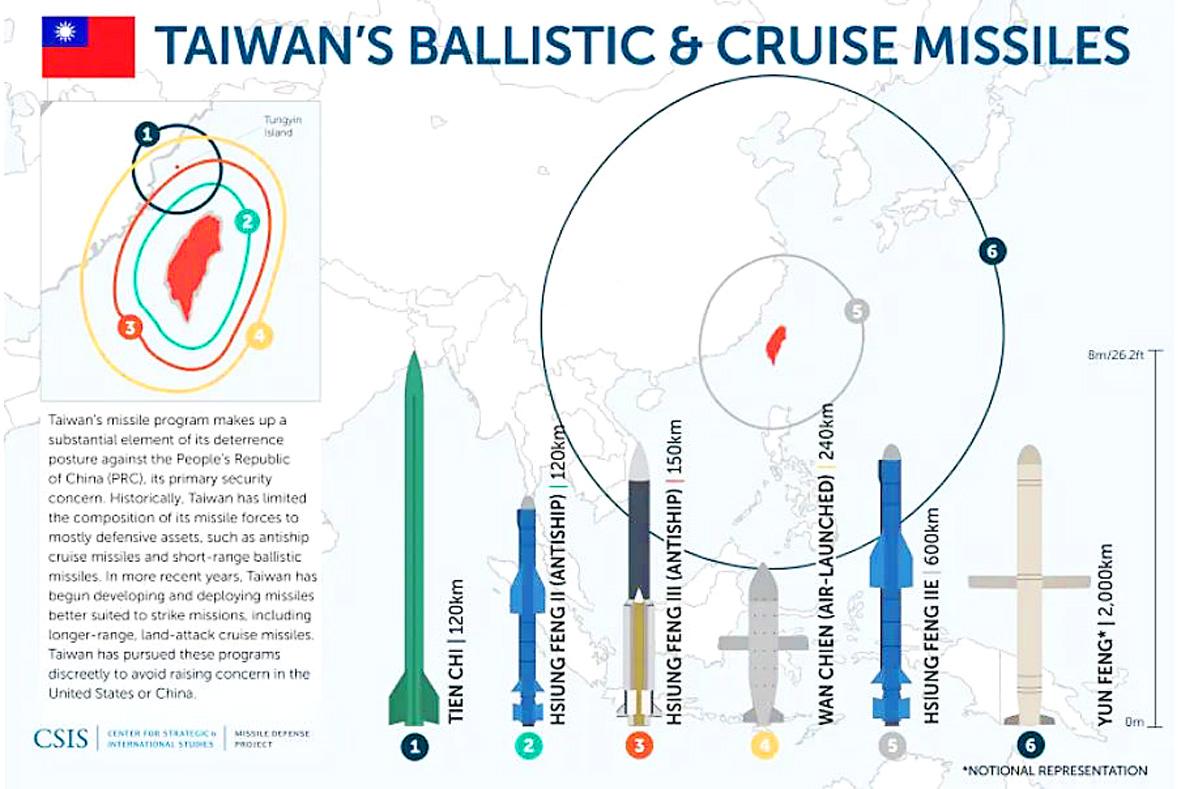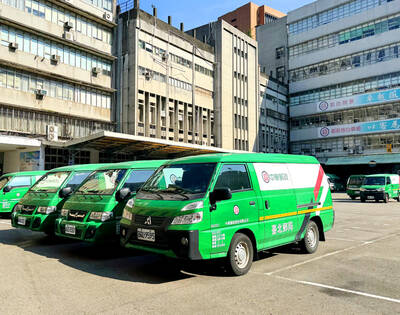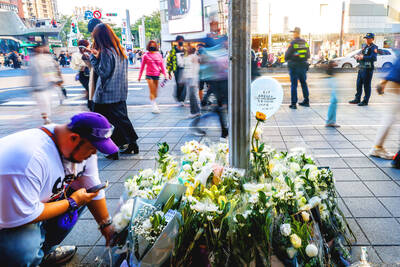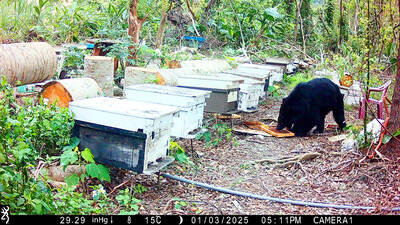China should think twice about invading Taiwan, as its Yun Feng (雲峰, Cloud Peak) missile could reach Beijing, Legislative Speaker You Si-kun (游錫堃) said yesterday.
You was presenting an online keynote speech on the Web forum www.taiwanus.net.
He said that when he was the premier he already knew that the Cloud Peak, a medium-range supersonic land-attack cruise missile developed in Taiwan, could reach Beijing. At the time he could not talk publicly about it, but now he could, as the missile is in mass production.

Photo: Screen grab from CSIS Web site
You was premier from Feb. 1, 2002, to Feb. 1, 2005.
Taiwan is not invading China, but China should take Taiwan’s ability to attack Beijing into consideration before launching an invasion, You said yesterday.
The Taiwan Strait is a natural barrier that provides a defensive advantage to Taiwan, so a Chinese invasion would be different from Russia’s invasion of Ukraine, he said.
Taiwan could use anti-ship missiles such as the Hsiung Feng III (雄風三型, Brave Wind III) against Chinese naval forces crossing the Taiwan Strait, he said, adding that if Chinese vessels managed to land, Taiwanese should have the determination to fight like the Ukrainians during Russia’s invasion of their country.
“God helps those who help themselves” is the most important lesson that Taiwan should learn from the Russia-Ukraine war, as good armaments and geographic location are useless without the will to defend, You said.
Separately, an expert said on Saturday that Taiwan should explore which weapons to use in asymmetric warfare during a potential cross-strait conflict.
Institute for National Defense and Security Research analyst Shu Hsiao-huang (舒孝煌) was responding to media queries about Taiwan’s military cooperation with the US.
US Secretary of Defense Lloyd Austin said on Saturday at the Shangri-La Dialogue in Singapore that the US has not changed its Taiwan policy and would continue helping Taiwan to bolster its self-defense capabilities.
However, critics in Taiwan have said that some arms purchases from the US have been canceled, including M109A6 Paladin self-propelled howitzers, MH-60R anti-submarine helicopters and Black Hawk search-and-rescue helicopters.
The Ministry of National Defense has said that the M109A6 order was canceled due to a “crowded” production line and the other two were called off due to their high costs.
The US Congress passed the US National Defense Authorization Act last year, recommending that the US Department of Defense invite Taiwan to this year’s Rim of the Pacific (RIMPAC) military exercise, but Taiwan was not invited, according to the invitation list of 26 countries released last month.
Some analysts said the changes in arms sales and lack of a RIMPAC invitation indicated that the US hopes Taiwan will stick to asymmetric warfare tactics, while some suspected that military cooperation between the two sides had experienced setbacks.
The asymmetric warfare strategy is based on a consensus between Taiwan and the US, National Taiwan University associate professor of political science Chen Shih-min (陳世民) said on Saturday, adding that the US basically hopes to maintain cross-strait peace and stabilize the relationships between the US, China and Taiwan.
The participants in RIMPAC are all sovereign nations, so the US did not invite Taiwan so as not to infuriate China, he added.
Shu said Taiwan is facing “asymmetric” threats from China. For example, uncrewed aerial vehicles (UAVs) are widely used by China’s military, but rarely used by Taiwanese forces.
He said that Taiwan should thoroughly re-examine its defense plans for a potential cross-strait war, make its own asymmetric warfare plans and communicate its needs to the US.
China boasts some of the best UAV technology in the world, which is far more advanced than the drones used by the two sides in the Russia-Ukraine war, but the strategies Taiwan and the US have been discussing have failed to include plans to counter UAVs, he said.

SHIPS, TRAINS AND AUTOMOBILES: The ministry has announced changes to varied transportation industries taking effect soon, with a number of effects for passengers Beginning next month, the post office is canceling signature upon delivery and written inquiry services for international registered small packets in accordance with the new policy of the Universal Postal Union, the Ministry of Transportation and Communications said yesterday. The new policy does not apply to packets that are to be delivered to China, the ministry said. Senders of international registered small packets would receive a NT$10 rebate on postage if the packets are sent from Jan. 1 to March 31, it added. The ministry said that three other policies are also scheduled to take effect next month. International cruise ship operators

HORROR STORIES: One victim recounted not realizing they had been stabbed and seeing people bleeding, while another recalled breaking down in tears after fleeing A man on Friday died after he tried to fight the knife-wielding suspect who went on a stabbing spree near two of Taipei’s busiest metro stations, Taipei Mayor Chiang Wan-an (蔣萬安) said. The 57-year-old man, identified by his family name, Yu (余), encountered the suspect at Exit M7 of Taipei Main Station and immediately tried to stop him, but was fatally wounded and later died, Chiang said, calling the incident “heartbreaking.” Yu’s family would receive at least NT$5 million (US$158,584) in compensation through the Taipei Rapid Transit Corp’s (TRTC) insurance coverage, he said after convening an emergency security response meeting yesterday morning. National

PLANNED: The suspect visited the crime scene before the killings, seeking information on how to access the roof, and had extensively researched a 2014 stabbing incident The suspect in a stabbing attack that killed three people and injured 11 in Taipei on Friday had planned the assault and set fires at other locations earlier in the day, law enforcement officials said yesterday. National Police Agency (NPA) Director-General Chang Jung-hsin (張榮興) said the suspect, a 27-year-old man named Chang Wen (張文), began the attacks at 3:40pm, first setting off smoke bombs on a road, damaging cars and motorbikes. Earlier, Chang Wen set fire to a rental room where he was staying on Gongyuan Road in Zhongzheng District (中正), Chang Jung-hsin said. The suspect later threw smoke grenades near two exits

The Forestry and Nature Conservation Agency yesterday launched a gift box to market honey “certified by a Formosan black bear” in appreciation of a beekeeper’s amicable interaction with a honey-thieving bear. Beekeeper Chih Ming-chen (池明鎮) in January inspected his bee farm in Hualien County’s Jhuosi Township (卓溪) and found that more than 20 beehives had been destroyed and many hives were eaten, with bear droppings and paw prints near the destroyed hives, the agency said. Chih returned to the farm to move the remaining beehives away that evening when he encountered a Formosan black bear only 20m away, the agency said. The bear